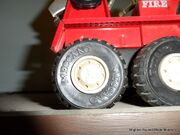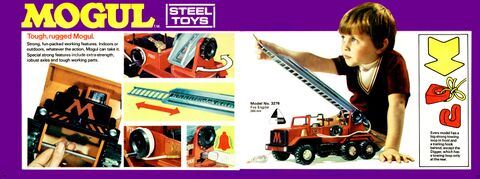Mogul Fire-Fighter (Meccano)
| Exhibit |
|---|
Mogul Fire-Fighter (Meccano) Wheel detail of the Mogul fire truck, showing the Meccano name and prominent Meccano-Mogul letter "M" (i) Wheel detail of the Mogul fire truck, showing the Meccano name and prominent Meccano-Mogul letter "M" (i)
|
 |
| location: |
A chunky red six-wheeler Mogul Fire-Fighter vehicle, made by Meccano in the 1970s.
The vehicle is mostly made from heavy folded steel, and has a silver extendable ladder on a rotatable platform with a metal bell, pairs of gold plastic water-cannon and bells (non-functional), a pair of hose reels with white toy metal-tipped hoses that appear to have a bootlace-style construction, a black metal undercarriage and chunky black plastic wheels with (white?) hubs.
The Mogul range were launched in 1974, with publicity materials showing the first five of six initial models.
The Fire-Fighter vehicle was one of a further set of three models launched in 1975.
Design
The toy has a black radiator grille featuring a prominent Meccano/Mogul - style "M", which also appears on the wheelhubs. The tyres have "MECCANO" embossed in their sides, twice per tyre.
Stylistically, the truck is reminiscent of a Tonka Toys toy, with heavy steel construction and blunt corners designed to minimise impact damage. It also (unsurprisingly) looks a little like the Meccano Multikit vehicles. Overall, the truck has a "construction vehicle" feel to it, with an open two-seater cab with rollbar, followed by a short open section with side-seating and the water-cannon, and finally the ladder turntable.
Meccano-style holes
While we haven't tried disassembling the vehicle, it does appear that the turntable section might be removable with three screws, to give a simple short flatbed section with a few rows of exposed "Meccano" (-size and -spacing) holes.
Intriguingly, the chassis underneath the mid-section is pierced by a full 7×5 Meccano-style hole grid (with outliers), but since this is under a part of the superstructure that's held on with bent metal tabs, it's not obvious whether the vehicle was supposed to be disassembled by brave owners armed with pliers, or whether the hole grid was there to allow alternative model variations to be built back at the factory.
There's enough clearance under the turntable for Meccano strips or other pieces to be bolted onto the vehicle to allow some limited customisation even if the ladder doesn't turn out to be removable.



